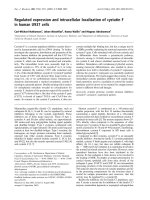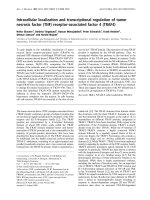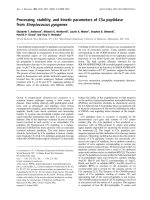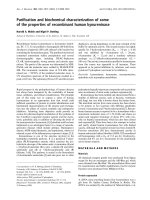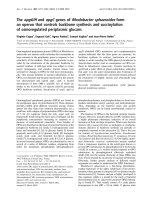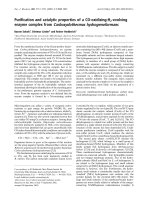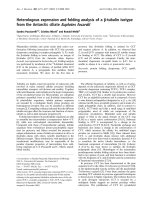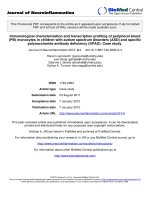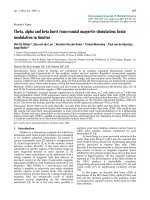Báo cáo y học: " Criterion distances and environmental correlates of active commuting to school in children" pps
Bạn đang xem bản rút gọn của tài liệu. Xem và tải ngay bản đầy đủ của tài liệu tại đây (464.84 KB, 10 trang )
RESEARCH Open Access
Criterion distances and environmental correlates
of active commuting to school in children
Sara D’Haese
1*
, Femke De Meester
1
, Ilse De Bourdeaudhuij
1
, Benedicte Deforche
1,2
and Greet Cardon
1
Abstract
Background: Active commuting to school can contribute to daily physical activity levels in children. Insight into
the determinants of active commuting is needed, to promote such behavior in children living within a feasible
commuting distance from school. This study determined feasible distances for walking and cycling to school
(criterion distances) in 11- to 12-year-old Belgian children. For children living within these criterion distances from
school, the correlation between parental perceptions of the environment, the number of motorized vehicles per
family and the commuting mode (active/passive) to school was investigated.
Methods: Parents (n = 696) were contacted through 44 randomly selected classes of the final year (sixth grade) in
elementary schools in East- and West-Flanders. Parental environmental perceptions were obtained using the parent
version of Neighborhood Environment Walkability Scale for Youth (NEWS-Y). Information about active commuting
to school was obtained using a self-reported questionnaire for parents. Distances from the children’s home to
school were objectively measured with Routenet online route planner. Criterion distances were set at the distance
in which at least 85% of the active commuters lived. After the determination of these criterion distances, multilevel
analyses were conducted to determine correlates of active commuting to school within these distances.
Results: Almost sixty percent (59.3%) of the total sample commuted actively to school. Criterion distances were set
at 1.5 kilometers for walking and 3.0 kilometers for cycling. In the range of 2.01 - 2.50 kilometers household
distance from school, the number of passive commuters exceeded the number of active commuters. For children
who were living less than 3.0 kilometers away from school, only perceived accessibility by the parents was
positively associated with active commuting to school. Within the group of active commuters, a longer distance to
school was associated with more cycling to school compared to walking to school.
Conclusions: Household distance from school is an important correlate of transport mode to school in children.
Interventions to promote active commuting in 11-12 year olds shoul d be focusing on children who are living
within the criterion distance of 3.0 kilometers from school by improving the accessibility en route from children’ s
home to school.
Background
Being physically active can help to reduce the prevalen ce
of obesity in child ren [1], is associated with a decrease in
cardiovascular risk factors [2] and may reduce the risk of
osteoporosis at older age [3]. At 11-12 years of age how-
ever, physical activity levels rapidly decline [4-6]. As a
high level of physical activity in 9- to 18-year-olds pre-
dicts a high level of adult physical activity [7], it is impor-
tant to promote physical activity during childhood.
Active commuting to school can contribute to achiev-
ing the recommended physical activity levels in elemen-
tary schoolchildren [8-10] of at least 60 minutes of
moderate to vigorous physical activity (MVPA) per day
[11]. In a study of Cooper et al., children who walked to
school were significantly more physically active than
those who travelled by car [8]. Cycling to school was
associated with higher overall physical activity levels, only
in boys [8]. Sirard et al. showed in the USA, that regularly
active commut ing children from elementary school from
the fifth grade (mean age 10.3 ± 0.6 yr), were approxi-
mately 24 minut es more engage d in MVPA per day [10].
These findings emphasize the importance of promoting
* Correspondence:
1
Faculty of Medicine and Health Sciences, Department of Movement and
Sports Sciences, Ghent University, Watersportlaan 2, 9000 Ghent, Belgium
Full list of author information is availabl e at the end of the article
D’Haese et al. International Journal of Behavioral Nutrition and Physical Activity 2011, 8:88
/>© 2011 D’Haese et al; licensee BioMed Central Ltd. This is an Open Access articl e distributed under the terms of the C reative Commons
Attribution License ( which permits unrestricte d use, distribution, and rep roductio n in
any medium, provided the original work is properly cited.
active commuting in children from elementary school to
enhance physical activity levels in children. However, to
promote active commuting in elementary school, it is
necessary to gain insight into correlates of active com-
muting behavior in schoolchildren.
Recently, ecological models got increasing attention.
The focus of ecological models is on the determination
of built an d natural environmental cause s of behavior
[12]. Besides the physical environment, interpersonal
and cultural factors also i nfluence behavior according to
the ecological model [13]. It is hypothesized that envir-
onmental factors can influence behaviors as well directly
as indirectly [14]. These theories suggest a profound
investigation of the neighborhood envir onment in order
to create suitable interventions.
According to the review of Panter et al., the physical
environment is one of the four main domains that can
influence active travel behavior [15]. Other affe cting fac-
tors are individual factors (e.g. physical ability, parental
characteristics, motivation, ), external factors (e.g.
weather, cost of travel and government policy), and
main moderators (age, gender and distance to destina-
tion) [15]. As the physical environment is changeable,
and a change of the environment can have positive
influences for the whole community, insight into this
domain may be indispensable, with an eye on creating
appropriate interventions to encourage active c ommut-
ing in schoolchildren.
According to the review of Panter et al. [15], one of the
most important and consistent predictors of active com-
muting to school, is the house hold distance from school.
Household distance from school is negatively associated
with active commuting to school. Australian children
were more likely to actively commute to school if their
route was < 800 meters [16]. Moreover, Merom et al.
[17] showed, that the number of Australian schoolchil-
dren that did not actively commute to school doubled
when distance increased from 750 m to 1500 m. As
household distance from school is the most important
predictor of active commuting to school, investigating
other predictors for children living within a feasible dis-
tance from school for active commuting is of interest.
Therefore, criterion distances for walking and cycling;
which represent feasible distanc es for active commuting
to school in elementar y school children should be deter-
mined. Van Dyck et al. (2010), d etermined criterion dis-
tances for Belgian older adolescents (17-18 years) for
both cycling (8.0 kilometers) and walking (2.0 kilometers)
[18]. As older adolescents might have a greater indepen-
dent mobility compared to children, and independent
mobility may differ between children of different ages,
it is necessary to determine more age-specific criterion
distances for Belgian c hildren. Passive commuters, who
are living within these criterion distances, should be the
focus of interventions to promote active commuting to
school.
The environmental correlates of active commuting to
school in children within these criterion distances, need
to be revealed. Several perceived environmental factors
have been identified as predictors of children’ stravel
behavior [15,19,20]. Studies in Australia [21] and the
USA [22] highlighted that parental concern about safety
was associated with less walking and cycling to school.
Parental perceptions of no traffic lights o r crossings for
their child to use, good connectivity e n route to school
and having to cross busy roads to get to school were all
negatively associated with walking or cycling to school in
Australia [16]. Results from a national survey in the USA
suggested that having sidewalks is an important feature
to promote active commuting to school in children [23].
Alton et al. [24], found in the UK that child perceptions
of parental concern about heavy traffic and unsafe streets
were associated with more walking in general. In Portu-
gal, a positive association was found between street con-
nectivity and walking to school [25]. Panter et al. [26]
found in the UK a moderating effect for distance,
whereby attitudes were more important for short dis-
tances and safety concerns for long distances. The pos-
session of more than one car per household seemed not
to be associated with active commuting to school in one
Australian study [17] whereas in another Australian
study, lesser car ownership was associated with more
walking to school [27]. Furthermore, studies rarely inves-
tigated the correlates for walking and cycling separately.
However, de Vries et al. showed that environmental
correlates of walking and cycling in children, differ by
purpose and commuting mode [28]. Therefore, it is
necessary to investigate environmental correlates sepa-
rately for walking and cycling, and for the different pur-
poses such as active commuting to school, active
commuting during leisure time and recreational walking
or cycling [28].
According to the review of Panter et al. [15] most stu-
dies that revealed environmental correlates of active
commuting were conducted in the USA and in Australia.
In this review, 13 out of 24 studies were conducted in the
USA, 7 studies were conducted in Australia and only 4
studies were conducted in Europe (Norway, Portugal, the
Netherlands and the UK) [15]. It is likely that, in these
countries, other predictors are responsible for active tra-
vel behavior to school; due to a different design and use
of urban areas in which motor vehicle use is strongly
existing, when compared to Flanders in Belgium. Flan-
ders is the Dutch-speaking part of Belgium. The mild sea
climate, the flat landscape and the dense network of cycle
tracks (12.000 kilometers cycle tracks) make from Flan-
dersacycle-friendlyregioninwhichtheprevalenceof
walking and cycling in general is much higher compared
D’Haese et al. International Journal of Behavioral Nutrition and Physical Activity 2011, 8:88
/>Page 2 of 10
to other countries [29]. Moreover, more than 80% of the
Flemish households own at least one bike [30]. Children
in Belgium are not obliged to wear bicycle helmets.
Mostly, bikes are stored at commo n places at school and
theft is not a problem at elementary schools.
In conclusion, there is lack of age-specific criterion
distances a nd, consequently, lack of European evidence
concerning environmental correlates of active commut-
ing to school in children living within their age-specific
criterion distances.
Consequently, the aim of this study was to determine
criterion distances fo r walking and cycling to school in
Flemish 11- to 12-year-old children. After the determi-
nation of these criterion distances, multidimensional
correlates of transport mode choice to school were
examined for c hildren living within the cri terion dis-
tance from school.
Methods
Procedure
All data of the present study were obtained through the
parents. Parental reports of active commuting to school
were incl uded in this study; as they are consid ered to be
more reliable compared to children’s data at that age [31].
Parental perception of the neighborhood was used instead
of children’s data as the framework by Panter et al. defined
the parents as the most important decision makers for the
choice of travel method to school in children [15].
The parents were reached t hrough the schools of their
child. In total, 148 schools were randomly selected from
all elementary schools in East- and West-Flanders in Bel-
gium and contacted by phone. From these schools, 44
principals agreed to let the sixth grade classes of their
school participate (response rate schools = 42,9%) and
gave written informed consent. The rather low response
rate of 42.9% of the schools was comparable to other
prior studies, based on questionnaires for pupils and par-
ents, and is due to the fact that schools have many obli-
gations and are consequently not very keen on spending
time on research activities.
From each school, only one randomly selected class
was included in the study to guarantee sufficient diver-
sity in the dataset. The number of pupils per class varied
from 6 to 23, and children were mainly 11-12 years old.
Through these 44 classes, 996 parents (one parent per
child) could be reached. The parents of 696 children gave
informed consent and were involved in the study
(response rate parents = 69,9%). Children took the ques-
tionnaires from school to home and parents completed
the questionnaire at home.
The 70% response rate of the parents was high and as
49.3% of th e parents included in the study obtained a
college or university diploma, this is a slightly higher
percentage compared to 41.2% of the 25 to 29 year old
people in 2007 [32]. The mean age of the parents’
children was 11.2 ± 0.5 years of which 52.0% were boys.
Data were collected between October 2009 and May
2010. The Ethics Commit tee of the Ghent University
Hospital approved the study.
Measures
Sociodemographic information
Parents were asked to fill in their own age, gender, a nd
their level of education and their partner’s level of educa-
tion. Educational attainmentwasusedasameasurefor
SES, as educational attainment is easy to measure and is
fairly stable beyond early adulthood, and higher levels of
education are usually associated with better jobs, hous-
ing, neighborhoods, working c onditions and higher
incomes [33]. Families were classified as high SES-
families if the educational level of at least one parent was
of a college or a university level; families were classified
as low SES families if none of both parents reached a col-
lege or a university education level. Parents were also
asked to fill in the number of motorized vehicles in their
family.
Active commuting
The part of the questionnaire about active commuting was
based on the validated Flemish Physical Activity Question-
naire (FPAQ) [34]. The questionnaire included the ques-
tion: ‘How does your child usually go to school?’ There
were three response categories: on foot, by bike, or with
motorized transport (by car, train or bus). The time it
took to go from home to scho ol for their child, was also
asked in the questionnaire. Furthermore, the parents were
asked to indicate on which days their children usually
came home during lunchbreak. Based on this information,
the number of minutes that children were weekly engaged
in active commuting to school was calculated. Parents also
filled in their household address. Routenet online route
planner (t enet.be) was used to objectively
determine the distance of the shortest route from each
child’s home to school.
Environmental perceptions
The parent version of the ‘Neighborhood Environment
Walkability Survey for Youth’ (NEWS-Y) in Dutch was
used to determine environmental perceptions of the
neighborhood. Internal consistency for all subscales and
test-retest reliability of NEWS-Y for parents of 5-11
year old children was found to be a cceptable with an
intra class correlation range from 0.56 for street connec-
tivity to 0.87 for crime safety [35].
The NEWS-Y determines the perceptions of residen-
tial density, the accessibility and diversity of land use
mix, street connectivity, walk- and cycle infrastructure,
aesthetics of the neighborhood and crime- and traffic
safety. All determinants were calculated following the
NEWS-Y scoring guidelines [36] with a higher score,
D’Haese et al. International Journal of Behavioral Nutrition and Physical Activity 2011, 8:88
/>Page 3 of 10
denoting better conditions for active commuting. An
outline of the questions is presented in table 1. All ques-
tions were rated on a five point scale and recoded were
necessary. Response options are represented in table 1.
Following the NEWS-Y rating scale [36], residential den-
sity was calculated by the following formula: score on
question 1a + 12* score on question 1b + 25*score on
question 1c. All the other subscales were scored by taking
the mean of the different question scores. A measure for
walkability was obtained by using following formula: walk-
ability z-score = z-score residential density + 2*z-score
connectivity + z-score land use mix [37].
Data analysis
SPSS 15.0 was used to describe the characteristics of the
sample.
Two-level bivariate regression analyses were conducted
using MLwiN version 2.20. A two-level hierarchical model
(school-pupil) was used to take into account clustering of
children in schools. Two-level regressions investigated the
relationship between the children’s transport mode choice
to school (active/passive co mmuting: dummy variable),
and household distance from school.
Two-level logistic regressions investigated the relation-
ship between the children’ s transport mode choice to
school (active/passive commuting: dummy variable), and
family SES (high/low: dummy variable) and gender (boy/
girl: dummy variable).
Criterion d i stances f or walking, cyc ling and passive com-
muting to school, were determined by examining cumula-
tive percentages of children commuting to school by bike,
on foot and in a passive way, per covered distance. Criter-
ion distances were set at the distance in which at least 85%
of the active commuters lived [18]. These distances were
supposed to be feasible distances for children to actively
commute to s chool.
After determination of these criterion distances, cor-
relates of active commuting to school for children liv-
ing within these feasible distances were determined.
Therefore, multivariate regression analyses were con-
ducted using MLwiN version 2.20. Two-level logistic
regressions investigated the multivariate relationship
between the children’s transport mode choice to school
(active/passive commuting: dummy variable), and par-
ental neighborhood perceptions and number of motor-
ized vehicles per family in the first model. In a second
model, the relationship between active transport mode
(on foot/by bike: dummy variable) and the independent
variables was examined. Household distance from
school was included as controlling variable within the
second model. The multilevel analyses were both con-
trolled for gender and SES of the parents. For each
independent variable, odds ratio and confidence inter-
val were given in table 2.
Before executing the multivariate analyses, multicolli-
nearity among independent variables was tested by
performing pearsons’ correlations. We used the value of
r > 0.4 as an indication of collinearity [38]. None of the
variables was excluded as there were no correlations > 0.4
found. Two independent variables, household distance
from school and number of motorized vehicles, were initi-
ally skewed (skewness > 0.7). Therefore, logarithmic trans-
formations (log
10
)weremadetoimprovenormalityof
these two independent variables [39]. All continuous vari-
ables were mean centered before they were inserted into
the models [40].
For all analyses, P-values ≤ 0.05 were considered as
significant.
Results
Descriptive characteristics
Almost sixty percent (59.3%) of the total sample com-
muted actively to school (38.1% by bike and 21.2% on
foot). Of the active c ommuters, 54.5% were boys and
45.5% were girls. In the girls’ subsample, 55.5% commuted
to school in an active way whereas more than sixty percent
(63.0%) of the boys commuted actively to school. These
differences were not significant (OR = 1.324; CI = 0.974 -
1.802). According to SES, there were no differences found
in commuting mode to school in children (OR = 0.914,
CI = 0.652 - 1.280).
Children lived on average 2.96 ± 3.97 kilometers away
from school (range: 0.05 - 33.50 kilometers). Passive
commuters lived further away from school (4.70 ± 4.67
kilometers) co mpared to active comm uters (1.73 ± 2.83
kilometers) (p < 0.001). The mean duration of an active
trip (by bike or on foot) to school was 9.4 ± 6.0 min-
utes. A biking trip took 9.7 ± 6.1 minutes and a trip by
foot took 8.8 ± 5.8 minutes on average. Children, who
commuted actively to school, were engaged in active
commuting for 111.4 ± 69.1 minutes weekly.
Determination of criterion distances
Figure 1 shows that 86.4% of the children who walk to
school lived within 1.5 kilometers from school. Of all chil-
dren who cycled to school, 86.8% lived less than 3.0 kilo-
meters away from school. Therefore, criterion distances
were set at 1.5 kilometers for walking and 3.0 kilometers
for cycling to school in Belgian 11-12 year old children. Of
the passive commuters, 47.7% lived within 3.0 kilometers
from school.
Figure 2 shows the division of commuting modes by
household distance from school. The percentage of chil-
dren commuting by car increases, while the number of
children using active commuting modes decreases when
the household distance from school increases.
Figure 3 represent s the number of children (%) that
walked, cycled or commuted passively to school per
D’Haese et al. International Journal of Behavioral Nutrition and Physical Activity 2011, 8:88
/>Page 4 of 10
Table 1 Outline of the NEWS-Y parent version
Nr Questions about the neighborhood n Parental
mean
1 Residential density (None/A few/Half/Most/All the residences) 632 79.30
1a How common are separate or stand alone one family homes? 667 3.09 ± 1.23
1b How common are connected townhouses or row houses? 671 2.92 ± 1.09
1c How common are apartment or condo buildings? 642 1.68 ± 0.79
2 Accessibility (Strongly disagree/Somewhat disagree/Sometimes I agree; Sometimes I disagree/Somewhat agree/
Strongly agree)
692 3.47 ± 1.14
2a From our home, it is easy to walk to school. 688 3.25 ± 1.68
2b There are many places where my child can walk to, alone or with someone else. 691 3.27 ± 1.42
2c It is easy to walk from one place to another (there is no motorway, railway or river). 687 3.73 ± 1.27
2d It is easy to walk to a play garden or a park. 686 3.62 ± 1.40
3 Land use mix (1-5 min/6-10 min/11-20 min/21-30 min/> 30 min) 684 3.34 ± 1.02
How long should it take to walk to
3a convenience/small grocery store? 646 3.59 ± 1.22
3b supermarket? 668 3.07 ± 1.34
3c bakery? 677 3.82 ± 1.16
3d butcher’s? 669 3.54 ± 1.23
3e newspaper stand? 670 3.49 ± 1.27
3f bank? 641 2.97 ± 1.34
3g library? 666 2.79 ± 1.32
4 Street connectivity (Strongly disagree/Somewhat disagree/Sometimes I agree; Sometimes I disagree/Somewhat agree/
Strongly agree)
689 3.40 ± 0.91
4a The streets have many cul-de-sacs. 686 3.56 ± 1.28
4b There are many intersections. 687 3.24 ± 1.15
5 Walking/Cycling facilities (Strongly disagree/Somewhat disagree/Sometimes I agree; Sometimes I disagree/Somewhat
agree/Strongly agree)
692 2.71 ± 0.88
5a There are sidewalks on most of the streets. 691 3.36 ± 1.37
5b There are bikeways on most of the streets. 688 2.53 ± 1.21
5c Bikeways are separated from the road/traffic by parked cars. 688 2.06 ± 1.11
5d There are bicycle sheds (at supermarkets, schools, bus stops ). 686 2.91 ± 1.21
6 Neighbourhood aesthetics (Strongly disagree/Somewhat disagree/Sometimes I agree; Sometimes I disagree/somewhat
agree/strongly agree)
694 3.27 ± 0.88
6a There are many trees along the streets. 694 3.09 ± 1.211
6b There is a beautiful scenery. (e.g. a beautiful landscape or view) 694 3.43 ± 1.25
6c There are many buildings/homes that are nice to look at. 693 3.29 ± 0.98
7 Traffic safety (Strongly disagree/Somewhat disagree/Sometimes I agree; Sometimes I disagree/Somewhat agree/
Strongly agree)
692 2.85 ± 0.68
7a Walking is dangerous because of the traffic. 690 3.23 ± 1.04
7b Cycling is dangerous because of the traffic. 691 2.84 ± 1.04
7c Cars usually drive slowly. 690 2.45 ± 0.99
7d Our streets have good lightning at night. 691 3.31 ± 0.99
7e There are crosswalks and signals to help walkers cross busy streets. 689 3.04 ± 1.12
7f It is safe to play on the streets.
691 2.24 ± 1.278
8
Crime safety (Strongly disagree/Somewhat disagree/Sometimes I agree; Sometimes I disagree/Somewhat agree/
Strongly agree)
693 3.46 ± 0.74
8a There is a low crime rate. 686 3.79 ± 0.94
8b It is necessary to be afraid of strangers when I am/my child is walking down the street alone. 666 3.33 ± 1.03
8c It is necessary to be afraid of when I am/my child is alone in a playground or a park. 661 3.25 ± 1.06
8d My bike is safe when I lock it. 669 3.44 ± 1.02
Residential density was calculated by following formula: score on question 1a + 12*score on question 1b + 25*score on question 1c. All the other subscales were
scored by taking the mean of the different question scores on a 5 point scal e.
D’Haese et al. International Journal of Behavioral Nutrition and Physical Activity 2011, 8:88
/>Page 5 of 10
distance range. In the sample of the active commuters,
the number of cyclists exceeded the number of children
whowalkedtoschoolintherangefrom0.51-1.00
kilometers. In the range of 2.01-2.50 kilometers, the
number of passive commuters exceeded the number of
the active commuters. There is a decrease in the num-
ber of children using motorized transport to go to
school and an increase of active commuting, due to an
increase in the number of children cycling to school in
the r ange of 3.0 0 - 4.00 kilometers. This can be due to
the smaller sample size (n = 53)inthisdistancerange.
We would expect a continuous increase in the number
ofpassivecommuters,andacontinuousdecreaseinthe
number of active commuters as the household distance
from school increased.
Correlates of active commuting
Correlates of active commuting were determined for
children living within a distance of 3.0 kilometers from
school (n = 503). This distance was set as the criterion
distance for cycling to school in elementary school chil-
dren. Within this distance range (0.00 - 3.0 kilometers),
children whose paren ts reported a greater accessibility
to walk (OR = 1.83; 95% CI = 1.38-2.44) were more
likely to commute actively to school. The perceived
walkability index, walking/cycling facilities, neighbor-
hood aesthetics, safety from traffic and crime and the
number of cars in a household family; were all not sig-
nificantly associated with transport mode choice for
children living within a distance of 3.0 kilometers from
school.
Within the group of all active commuters (n = 369)
living within the criterion distance of 3.0 km, only the
household distance from school was significantly asso-
ciated with commuting to school by bike instead of
going to school on foot (OR = 7.24; 95% CI = 2.56-
20.51). Active commuting children living further away
from school, but still within the criterion distance of
3.0 kilometers, will prefer to commute to school by bike
instead of going on foot. After correction for household
distance from school, no other environmental correlates
were found.
Discussion
Theprevalenceofactivecommutinginthepresentsam-
ple of 696, 11- to 12-year-old children in Belgium,
(59.3%) is much highe r than the prevalence found in
Australia [17], the USA [23], and European countries
(e.g. Scotland, France, Portugal, ) [29]. As Flanders in
Belgian has a mild sea climate, a flat landscape and a
dense network of cycle paths; r ates of active commuting
to school can be much higher compared to other non-
cycle-friendly regions. Another explanation can be that in
Belgium , children from elementary schools live relatively
close to their school (mean distance to school 2.96 ± 3.97
kilometers) compared to children in Australia and the
USA [41], as the distance to school is the most important
negative predictor of active commuting. Results from this
study showed that the further children lived from school,
the less frequently they actively commuted to school by
walking or cycling. This finding is consistent among
our study and studies conducted in the USA [41] and
Australia [16,17].
As the distance to school incre ases, active commuting
children go more to school by bike instead of going to
school on foot. The criterion distance for walking (1.5
kilometers) is comparable with the criterion distance
reported in older adolescents by Van Dyck et al. [18].
The criterion distance for cycling, on the other hand, is
much higher in older adolescents (8.0 kilometers) than
the distance of 3.0 kilometers found in this study for
children. As cycling is a complex task and requires
Table 2 Logistic multi-level analyses of sociodemographic and environmental correlates of transportation mode to
school
Dependent variable: ACTIVE (= 1) OR PASSIVE (= 0) COMMUTING TO
SCHOOL n = 503
ACTIVE COMMUTING BY BIKE (= 1) OR ON FOOT
(= 0) n = 369
Predictor: b ± SD OR 95% CI b ± SD OR 95% CI
SES (ref: low SES) 0.272 ± 0.271 1,31 0.77 - 2.23 -0.346 ± 0.312 0,71 0.38 - 1.30
Gender (ref: male) -0.092 ± 0.325 0,91 0.48 - 1.72 -0.131 ± 0.367 0,88 0.43 - 1.80
Number of motorized vehicles -0.327 ± 1.049 0,72 0.09 - 5.64 -0.460 ± 1.097 0,63 0.07 - 5.42
Walkability 0.047 ± 0.057 1,05 0.94 - 1.17 -0.026 ± 0.066 0,97 0.86 - 1.11
Accessibility 0.607 ± 0.146 1,83 1.38 - 2.44* -0.272 ± 0.200 0,76 0.51 - 1.13
Walk/cycle facilities 0.250 ± 0.168 1,28 0.92 - 1.78 -0.261 ± 0,182 0,77 0.53 - 1.11
Neighborhood aesthetics -0.110 ± 0.166 0,9 0.65 - 1.24 0.005 ± 0.185 1,01 0.70 - 1.44
Safety from traffic 0.045 ± 0.239 1,05 0.65 - 1.67 0.287 ± 0.281 1,33 0.77 - 2.31
Safety from crime 0.013 ± 0.195 1,01 0.69 - 1.48 2,331 ± 0,226 1,26 0.81 - 1.96
Household distance from school 1.980 ± 0.531 7,24 2.56 - 20.51*
SE = standard error, 95% CI = 95% confidence interval, OR = odds ratio.
* p < 0.05.
D’Haese et al. International Journal of Behavioral Nutrition and Physical Activity 2011, 8:88
/>Page 6 of 10
more attention than walking [42], younger children may
be limited in their independent mobility by their parents
to ensure the safety of their child. Although, the results
of this study revealed that 3.0 kilometers is a feasible
distance for 11- to 12-year-old children for active com-
muting to school, 47.7% of the passive commuters lived
within the criterion distance for cycling to school.
Therefore, future interventions that are promoting active
commuting, need to focus on this group of passive com-
muters in which almost halfofthepassivecommuters
coul d be reached. As it is not possible to mod ify house-
hold distance from school, a different approach will be
needed to encourage children to commute actively to
school when they are living further than 3 km away
from school. A possible way is to create ‘drop off spots’
at 1.5 km from school (the criterion distance for walk-
ing), where parents can drop their chil dren e.g. on their
way to work. Teachers or volunteers can gu ide the chil-
dren from the drop spots to school and from school to
thedropspottoguaranteethesafetyofthechildren.
Also other safety issues need to be taken into account:
e.g. children should be advised to wear a fluorescent
traffic safety vest. Kingham et al. (200 7) showed in ele-
mentary schoolchildren that supervised walking pools
are feasible and have many advantages such as social,
0%
10%
20%
30%
40%
50%
60%
70%
80%
90%
100%
children cycling to school (%)
Household distance from school (km)
children cycling to school within each distance range
all children cycling to school (n=146)
0%
10%
20%
30%
40%
50%
60%
70%
80%
90%
100%
children walking to school (%)
Household distance from school (km)
children walking to school within each distance range
all children walking to school (n=269)
0%
10%
20%
30%
40%
50%
60%
70%
80%
90%
100%
Children going to school by car (%)
Household distance from school (km)
children going to school by car within each distance range
all children going to school by car (n=281)
Figure 1 Cumulative percentage of covered distance ranges
per transportation mode.
0
10
20
30
40
50
60
70
80
90
100
Divisionofcommutingmodes(%)
Household distance fromschool (km)
Divisionofcommutingmodestoschoolby
householddistancefromschool
%bycar
%cycling
%walking
Figure 2 The division of commuting modes to school by
household distance from school.
0
10
20
30
40
50
60
70
80
90
100
numberofchildre n (%)
Household distancefromschool (km)
passive
active
walking
cycling
Figure 3 Pe rcentages of children going to school by active or
passive commuting per distance range.
D’Haese et al. International Journal of Behavioral Nutrition and Physical Activity 2011, 8:88
/>Page 7 of 10
timesaving, safety and health benefits. Moreo ver,
children get used to walking and this can increase walk-
ing behavior in other family members [43].
In the range of 2.01 - 2.50 kilometers distance to
school, t he number of passive commuters already
exceeded the number of active commuters. This is
mainly due to a smaller number of children who walk
to school and a larger number of children who are dri-
ven to school from a household distance of more than
2.0 kilometers from school. From a household distance
of 2.0 kilometers from school, less than 4% of the chil-
dren went to school on foot, 23% went to school by
bike and 73% went to school by car.
By determining correlates of act ive commuting to
school for child ren who are living within the criterion
distance for cycling (3.0 kilometers), only access ibility to
walk seemed to be positively associated with active com-
muting to school. A better accessibi lity to wal k includes
an easy way to walk to school and many places where
children can easily walk to. Furthermore, in neighbor-
hoods with a better accessibility, there a re many places
where children can walk to alone or with someone else
and it is easy to walk to a play ground or a park.
It is mainly the responsibility of the government to
improve the accessibility. Improving accessibility brings
along radical changes. This includes the improvement of
the number and condition of t he cycle p aths and tracks.
However, it may include other features, as the definition
of accessibility is unclear in the NEWS-Y questionnaire.
Improving the accessibility will require time and money
and is a challenge for urban planners. The implication of
improving accessibility needs further research, especially
the cost-effectiveness of such interventions needs to be
studied, as these studies are rather scarce, especially in
children, where no studies were found. Two studies
investigating cost-effectiveness showed that community-
and street-scale urban design and land use policies and
practices can be effective in enhancing physical activity
levels in adults [44,45].
Besides “improving ac cessibility” it will be necessary to
pay attention to other potential (non-environmental)
influencing factors. It would not be sufficient to only
modify the environment . On the other side, focusing on
individual behaviors only, when the e nvironment is not
supportive, will produce weak and short term effects
[46]. According to Sallis et al., the most effective inter-
ventions are those that focus on four domains: intraper-
sonal, social, physical environmental, and policy [13].
Within the criterion distance of 3.0 kilometers, the
further the children lived from school, the less they went
to school in an active way. Even within the criterion dis-
tance range, distance is an i mportant correlate of active
commuting to school. It is rather surprising that safety
from traffi c and crime, walking and cycling facilities, and
walkability were not associated with active commuting to
school, as shown in other studies [16,21-23]. A possible
explanation may be the fact that during the last years, the
government in Belgium has invested in improving the
safety around schools. Crossing guards in front of the
school on crosswalks, traffic lights, speed limits of
30 km/h around schools are all implemented in most
Belgian elementary schools and walking and cycling facil-
ities around schools are mostly in good condition.
As found in Merom et al., the number of cars per
household was not associated with the choice of trans-
port mode to school [17]. As only 2.0% of the households
in this study did not have a car or another motorized
vehicle, a lack of power can be a possible explanation.
Probably the influence of having no car versus having
one or more cars will mainly make the biggest difference
on active commuting mode choice to school in children.
Among the active commuting children, bicycle use in
children was positively associated with a longer house-
hold distance from school. The main explanation for
this finding is probably the fact that it is usually faster
to bike than to go on foot. None o f the perceived envir-
onmental correlates by the parents did determine if
active commuters went to school on foot or by bike.
A first strength of the study was the sample size (n =
696). Compared by other similar studies, the present
sample size is relativel y large; as it exceeds most sample
sizes of similar studies. The second strength was the use
of parental perceptions instead of c hildren’s perception,
as the parents are usually the main decision makers for
the transport mode choice to school from their children.
Thirdly, the use of the NEWS-Y q uestionnaire, a vali-
dated questionnaire, is also a strength of this study.
Finally, distance to school was objectively determined
using online Routenet route planner.
This strength also entails a weakness, as over- or
underestimation of the distance is possible when using
an online routeplanner. The active traveled way can be
shorter (if short cuts exist) or longer (if lon ger but safer
routes exist) than the distance calculated with the online
route planner.
Another limitation is the fact that some children can
be driven to school in the m orning but going home on
foot in the afternoon or the other way around. Further-
more, the questionnaire did not make a distinction
between active, passive or ‘mixed transport’ commuters.
According to the results, there are children who walk
to school and live further than 5 km away from school.
This might be due to combined modes of transporta-
tion. For example, it can be possible t hat children are
dropped by their parents at their grandparents’ place
and that children continue their way to school on foot
D’Haese et al. International Journal of Behavioral Nutrition and Physical Activity 2011, 8:88
/>Page 8 of 10
from tha t place. As combined modes of transportation
were not included in the questionnaire, this was a lim-
itation of this study.
In addition, youth attitudes, external factors, and paren-
tal attitudes were not included in the study as potential
correlates of active commuting to school. However, these
determinants may be more amenable in the short term
than “improving accessibility” . Further research in this
domain is necessary. A last limitation is the cross-sectional
character of the study, therefore, no causal relationships
can be concluded. If commuting decreases over time in a
neighborhood with sustained accessibility, the determi-
nants will be more likely individuals factors. Longitudinal
studies are necessary to confirm these thoughts.
Conclusions
Household d istance from school is the most important
predictor of active commuting to school. According to
the present results, interventions to promote active
commuting in 11- to 12-year-old children should be
focusing on children living within a distance of 3.0 kilo-
meters from school by improving the accessibility to
walk on the way from children’s home to school.
In children who live further away from school, alter-
native strategies should be applied to enhance the daily
physical activity levels. Schools could be encouraged to
determine places at 1.5 kilometers from school where
parents can drop their children. This should be a feasi-
ble distance for children to walk to school from that
place.
Suggestions for further research may be the investiga-
tion of correlates of active commuting to school, based
on objective observations of the neighborhood. It is pos-
sibl e that parents from active commuters make a differ-
ent interpretation of the neighborhood as they are more
aware of risks, and facilities along the way to school
compared to parents from passive commuters. It might
be interesting to compare the results based on subjective
and objective neighborhood characteristics. The physical
environment is one of the four main domains that can
influence active travel behavior [15]. As there is only
one perceived environmenta l factor associated with
active commuting to school, it may be necessary to
focus in interventions on other affecting factors such as
individual factors and external factors [15].
By changing these individual factors (parental and
children’s attitude, self-efficacy, ) the criterion distances
could possibly be moved to a further household distance
from school and have an i mpact on numerous children,
living further away than the 3.0 km the criterion dis-
tances. Further research may be n ecessary to develop
appropriate interventions. Longitudinal studies are
necessary to investigate causal relationships.
Acknowledgements
The authors want to thank Evelyne Coppin, Ann-Sophie De Backer, Marlies
Delrue, Marloes Everaert, Bieke Moerman, Elien Moerman, Tine Vanden Bergh
and Fauve Vandendorpe for their assistance in data collection. This research was
supported by Ghent University Special Research Fund (BOF) BOF08/24J/134
Author details
1
Faculty of Medicine and Health Sciences, Department of Movement and
Sports Sciences, Ghent University, Watersportlaan 2, 9000 Ghent, Belgium.
2
Department of Human Biometrics and Biomechanics, Vrije Universiteit
Brussel, Brussels, Belgium.
Authors’ contributions
SDH conducted the statistical analyses and drafted the manuscript. FDM
developed the data collection protocol and coordinated the data collection.
GC, IDB, BD and FDM participated in the interpretation of the data, helped
to draft the manuscript and revised the manuscript for important intellectual
content. All authors read and approved the final manuscript.
Competing interests
The authors declare that they have no competing interests.
Received: 3 February 2011 Accepted: 10 August 2011
Published: 10 August 2011
References
1. Flynn MAT: Reducing obesity and related chronic disease risk in children
and youth: a synthesis of evidence with ‘best practice’
recommendations. Obesity Reviews 2006, 7:7.
2. Andersen L: Physical activity and clustered cardiovascular risk in children:
a cross-sectional study (The European Youth Heart Study). Lancet 2006,
368:299-304.
3. Cooper C, Cawley M, Bhalla A, Egger P, Ring F, Morton L, Barker D:
Childhood Growth, Physical-Activity, and Peak Bone Mass in Women.
Journal of Bone and Mineral Research 1995, 10:940-947.
4. van Mechelen W, Twisk JWR, Post GB, Snel J, Kemper HCG: Physical activity
of young people: the Amsterdam Longitudinal Growth and Health
Study. Medicine and Science in Sports and Exercise 2000, 32:1610-1616.
5. Trost SG, Pate RR, Sallis JF, Freedson PS, Taylor WC, Dowda M, Sirard J: Age
and gender differences in objectively measured physical activity in
youth. Medicine and Science in Sports and Exercise 2002, 34:350-355.
6. Riddoch CJ, Bo AL, Wedderkopp N, Harro M, Klasson-Heggebo L,
Sardinha LB, Cooper AR, Ekelund U: Physical activity levels and patterns of
9- and 15-yr-old European children. Medicine and Science in Sports and
Exercise 2004, 36:86-92.
7. Telama R, Yang X, Viikari J, Valimaki I, Wanne O, Raitakari O: Physical
activity from childhood to adulthood: a 21-year tracking study. American
Journal of Preventive Medicine 2005, 28:267-273.
8. Cooper AR, Andersen LB, Wedderkopp N, Page AS, Froberg K: Physical
activity levels of children who walk, cycle, or are driven to school.
American Journal of Preventive Medicine 2005, 29:179-184.
9. Cooper AR, Page AS, Foster LJ, Qahwaji D: Commuting to school - Are
children who walk more physically active? American Journal of Preventive
Medicine 2003, 25:273-276.
10. Sirard JR: Physical activity and active commuting to elementary school.
Medicine and Science in Sports and Exercise 2005, 37:2062.
11. Janssen I, Leblanc AG: Systematic review of the health bene fits of
physical activity and fitness in school-aged children and y outh.
International Journal of Behavioral Nutrition and Physical Activity 2010,
7:40.
12. McLeroy KR, Bibeau D, Steckler A, Glanz K: An ecological perspective on
health promotion programs. Health Education Quarterly 1988,
15:351-377.
13. Sallis JF, Bauman A, Pratt M: Environmental and policy interventions to
promote physical activity. American Journal of Preventive Medicine 1998,
15:379-397.
14. Kremers SP, de Bruijn GJ, Visscher TL, van MW, de Vries NK, Brug J:
Environmental influences on energy balance-related behaviors: a dual-
process view. International Journal of Behavioral Nutrition and Physical
Activity 2006, 3
:9.
D’Haese et al. International Journal of Behavioral Nutrition and Physical Activity 2011, 8:88
/>Page 9 of 10
15. Panter JR, Jones AP, van Sluijs EMF: Environmental determinants of active
travel in youth: A review and framework for future research. International
Journal of Behavioral Nutrition and Physical Activity 2008, 5.
16. Timperio A, Ball K, Salmon J, Roberts R, Giles-Corti B, Simmons D, Baur LA,
Crawford D: Personal, family, social, and environmental correlates of
active commuting to school. American Journal of Preventive Medicine 2006,
30:45-51.
17. Merom D, Tudor-Locke C, Bauman A, Rissel C: Active commuting to school
among NSW primary school children: implications for public health.
Health & Place 2006, 12:678-687.
18. Van Dyck D: Criterion distances and correlates of active transportation to
school in Belgian older adolescents. International Journal of Behavioral
Nutrition and Physical Activity 2010, 7:87.
19. Davison KK, Werder JL, Lawson CT: Children’s active commuting to school:
current knowledge and future directions. Preventing Chronic Disease 2008,
5:A100.
20. Pont K, Ziviani J, Wadley D, Bennett S, Abbott R: Environmental correlates
of children’s active transportation: a systematic literature review. Health
Place 2009, 15:827-840.
21. Ziviani J, Scott J, Wadley D: Walking to school: incidental physical activity
in the daily occupations of Australian children. Occupational Therapy
International 2004, 11:1-11.
22. Kerr J: Active commuting to school: associations with environment and
parental concerns. Medicine and Science in Sports and Exercise 2006, 38:787.
23. Fulton JE, Shisler JL, Yore MM, Caspersen CJ: Active transportation to
school: Findings from a national survey. Research Quarterly for Exercise and
Sport 2005, 76:352-357.
24. Alton D, Adab P, Roberts L, Barrett T: Relationship between walking levels
and perceptions of the local neighbourhood environment. Archives of
Disease in Childhood 2007, 92:29-33.
25. Mota J, Gomes H, Almeida M, Ribeiro JC, Carvalho J, Santos MP: Active
versus passive transportation to school-differences in screen time, socio-
economic position and perceived environmental characteristics in
adolescent girls. Annals of Human Biology 2007, 34:273-282.
26. Panter JR, Jones AP, van Sluijs EMF, Griffin SJ: Attitudes, social support and
environmental perceptions as predictors of active commuting behaviour
in school children. Journal of Epidemiology and Community Health 2010,
64:41-48.
27. Carlin JB, Stevenson MR, Roberts I, Bennett CM, Gelman A, Nolan T:
Walking to school and traffic exposure in Australian children. Australian
and New Zealand Journal of Public Health 1997, 21:286-292.
28. de Vries SI, Hopman-Rock M, Bakker I, Hirasing RA, van MW:
Built
environmental correlates of walking and cycling in Dutch urban
children: results from the SPACE study. International Journal of
Environmental Research and Public Health 2010, 7:2309-2324.
29. Sirard JR, Slater ME: Walking and Bicycling to School: A Review. American
Journal of Preventive Medicine 2009, 2:372-396.
30. Vlaamse overheid departement Mobiliteit en Openbare Werken: Onderzoek
Verplaatsingsgedrag Vlaanderen (OVG) 4.1 september 2008 - september 2009
2010.
31. Sirard JR, Pate RR: Physical activity assessment in children and
adolescents. Sports Medicine 2001, 31:439-454.
32. Federaal Rapport 2009. [ />r5nl_fichesite737.html].
33. Shavers VL: Measurement of socioeconomic status in health disparities
research. Journal of the National Medical Association 2007, 99:1013-1023.
34. Verstraete S, De Bourdeaudhuij I, Cardon G: Validation of a physical
activity questionnaire for children [abstract]. Medicine and Science in
Sports and Exercise 2003, 5:S337.
35. Rosenberg D, Ding D, Sallis JF, Kerr J, Norman GJ, Durant N, Harris SK,
Saelens BE: Neighborhood Environment Walkability Scale for Youth
(NEWS-Y): Reliability and relationship with physical activity. Preventive
Medicine 2009, 49:213-218.
36. Scoring for the Neighborhood Environment Walkability Scale - Youth
(NEWS-Y). [ />pdf].
37. Frank LD: The development of a walkability index: application to the
Neighborhood Quality of Life Study. British Journal of Sports Medicine
online 2010, 44:924.
38. Veitch J, Salmon J, Ball K: Individual, social and physical environmental
correlates of children’s active free-play: a cross-sectional study.
International Journal of Behavioral Nutrition and Physical Activity 2010, 7.
39. Osborne J: Notes on the use of data transformations. [http://www.
microbiologybytes.com/maths/graphics/transformation.pdf].
40. de Leeuw J, Meijer E: Introduction to Multilevel Analysis. In Handbook of
Multilevel Analysis. Volume 59. Edited by: de Leeuw J, Meijer E. New York:
Springer; 2008.
41. Schlossberg M, Phillips PP, Johnson B, Parker B: How do they get there? A
spatial analysis of a sprawl school in Oregon. Planning Practice and
Research 2005, 20:147-162.
42. Wierda M: Analysis of cycling skill: a cognitive approach. Applied Cognitive
Psychology 1991, 5:113.
43. Kingham S, Ussher S:
An assessment of the benefits of the walking
school bus in Christchurch, New Zealand. Transportation Research Part A:
Policy and Practice 2007, 41:502-510.
44. Heath GW, Brownson RC, Kruger J, Miles R, Powell KE, Ramsey LT, Task
Force on Community Preventive Services: The effectiveness of urban
design and land use transport policies and practices to increase physical
activity: a systematic review. Journal of Physical Activity and Health 2006,
3(1):S55-S76, Human Kinetics.
45. Roux L, Pratt M, Tengs TO, Yore MM, Yanagawa TL, Van Den BJ, Rutt C,
Brownson RC, Powell KE, Heath G, et al: Cost effectiveness of community-
based physical activity interventions. American Journal of Preventive
Medicine 2008, 35:578-588.
46. Sallis JF, Owen N, Fisher EB: Ecological Models of Health Behavior. In
Health Behavior and Health Education. 4 edition. Edited by: Glanz K, Rimer
BK, Viswanath K. United States of America: John Wiley and Sons;
2008:465-485.
doi:10.1186/1479-5868-8-88
Cite this article as: D’Haese et al.: Criterion distances and environmental
correlates of active commuting to school in children. International
Journal of Behavioral Nutrition and Physical Activity 2011 8:88.
Submit your next manuscript to BioMed Central
and take full advantage of:
• Convenient online submission
• Thorough peer review
• No space constraints or color figure charges
• Immediate publication on acceptance
• Inclusion in PubMed, CAS, Scopus and Google Scholar
• Research which is freely available for redistribution
Submit your manuscript at
www.biomedcentral.com/submit
D’Haese et al. International Journal of Behavioral Nutrition and Physical Activity 2011, 8:88
/>Page 10 of 10
